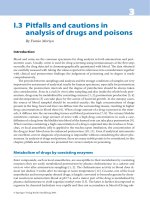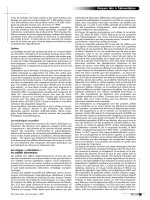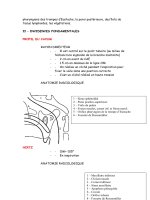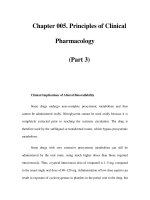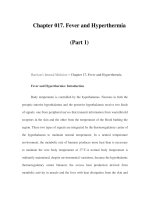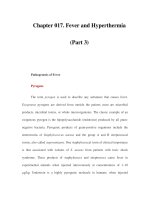Chapter 056. Cutaneous Drug Reactions (Part 3) docx
Bạn đang xem bản rút gọn của tài liệu. Xem và tải ngay bản đầy đủ của tài liệu tại đây (12.46 KB, 5 trang )
Chapter 056. Cutaneous
Drug Reactions
(Part 3)
DELAYED HYPERSENSITIVITY
Delayed hypersensitivity mechanisms directed by drug-specific T cells are
probably the most important mechanisms in the etiology of the most common drug
eruptions—morbilliform exanthems—and also of rare and severe forms such as
hypersensitivity syndrome, acute generalized exanthematous pustulosis (AGEP),
Stevens-Johnson syndrome (SJS), and toxic epidermal necrolysis (TEN). Drug-
specific T cells have been detected in these types of drug eruptions.
Contrary to what has been believed for years, the antigen is more often the
native drug itself than its metabolites. It remains to better understand why the
stimulation of T cells by medications leads to reactions that are clinically so
diverse. Some answers were provided by the study of effector cells obtained at the
site of skin lesions. Drug-specific cytotoxic T cells have been detected in the skin
lesions of fixed drug eruptions and of TEN. In TEN, blisters that result from
accumulation of interstitial fluid under the necrotic epidermis contain T
lymphocytes that are able to kill autologous lymphocytes and keratinocytes in a
drug-specific, HLA-restricted, and perforin/granzyme-mediated pathway.
Drug-specific clones producing CXCL8, a neutrophil-attracting chemokine,
were obtained from skin tests of patients with AGEP, a neutrophil-mediated drug
reaction.
One may therefore assume that the final pattern of drug eruptions results
both from the nature of effectors—cytotoxic T cells in blistering reactions,
chemokines in reactions mediated by neutrophils or eosinophils—and from the
intensity of stimulation and response.
GENETIC FACTORS AND CUTANEOUS DRUG REACTIONS
Specific genetically determined defects in the ability of an individual to
detoxify toxic reactive drug metabolites predispose such individuals to the
development of drug toxicity. It has also been suspected that a slow acetylator
phenotype increases the risk of rash from sulfonamides. However, in two large
prospective cohorts of HIV-infected patients treated with sulfonamides, no
association of drug eruption with acetylation genotype was found.
Recent literature shows that genetic factors may be important predictors of
severe drug reactions. Hypersensitivity to the anti-HIV medication abacavir was
strongly associated with HLA B*5701. In Taiwan, within a homogeneous Han
Chinese population, a 100% association was observed between SJS or TEN related
to carbamazepine and HLA B*1502. In the same population, another 100%
association was found between SJS, TEN, or hypersensitivity syndrome/drug
reaction with eosinophilia and systemic symptoms (DRESS) related to allopurinol
and HLA B*5801. These observations have important theoretical implications. By
pointing to HLA genes, they strongly support a key role for immune mechanisms.
However, the strong associations found in Taiwan have not been observed in other
countries with more heterogenous populations. Therefore, widespread practical
applications of these findings are not yet possible.
CLINICAL PRESENTATION OF CUTANEOUS DRUG
REACTIONS
Nonimmune Cutaneous Reactions
EXACERBATION OR INDUCTION OF DERMATOLOGIC
DISEASES
A variety of agents can exacerbate preexisting diseases or sometimes
induce a disease that may or may not disappear after withdrawal of the inducing
medication. For example, NSAIDs, lithium, beta blockers, and angiotensin-
converting enzyme (ACE) inhibitors can exacerbate plaque psoriasis, while
antimalarials can worsen pustular psoriasis. Acne may be induced by
glucocorticoids, androgens, and lithium. Minocycline and thiazide diuretics may
exacerbate subacute systemic lupus erythematosus, and pemphigus can be induced
by D-penicillamine, captopril, and other ACE inhibitors. The hypothesis that a
drug may be responsible should always be considered, especially in cases with
atypical clinical presentation, unusual age of onset, or unexpected evolution.
PHOTOSENSITIVITY ERUPTIONS
Photosensitivity eruptions are usually most marked in sun-exposed areas
but may extend to sun-protected areas. The mechanism is almost always
phototoxicity. Phototoxic reactions resemble sunburn and can occur with first
exposure to a drug. Their severity depends on the tissue level of the drug, its
efficiency as a photosensitizer, and the extent of exposure to the activating
wavelengths of ultraviolet light (Chap. 57).
Common orally administered photosensitizing drugs include many
fluoroquinolones and cycline antibiotics. Other drugs less frequently encountered
are chlorpromazine, thiazides, and several NSAIDs (ibuprofen, naproxen,
piroxicam). Because UV-A and visible light, which trigger these reactions, are not
easily absorbed by nonopaque sunscreens and are transmitted through window
glass, photosensitivity reactions may be difficult to block.
Photosensitivity reactions abate with removal of either the drug or
ultraviolet radiation, use of high-potency sunscreens that block UV-A light, and
treating the reaction as one would a sunburn. Rarely, individuals develop
persistent reactivity to light, necessitating long-term avoidance of sun exposure.

